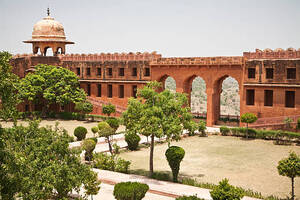Jaigarh Fort Jaipur - A Timeless Marvel of Rajasthan
Cuerpo
Jaigarh Fort, standing majestically on the rugged promontory of the Aravalli Range, is an enduring symbol of Rajasthan's rich history. Known as the "Fort of Victory," it offers breathtaking views of Jaipur city while preserving centuries of Rajput heritage. Its strategic location and fascinating past have made it one of the most significant attractions for tourists and history enthusiasts alike.
The Location of Jaigarh Fort
Jaigarh Fort is perched on the "Cheel ka Teela" or the Hill of Eagles, offering stunning panoramas of the surrounding landscape.
How to Reach Jaigarh Fort
- By Air: The nearest airport is Jaipur International Airport, around 30 km away.
- By Road: Accessible via well-maintained roads, approximately 15 km from Jaipur city center.
- By Rail: Jaipur Railway Station connects well with major Indian cities.
Best Time to Visit Jaigarh Fort
The best time to visit is during the winter months (October to March) when the weather is pleasant, making the exploration more enjoyable.
Historical Background
Origin and Construction of Jaigarh Fort
Constructed in 1726 by Maharaja Sawai Jai Singh II, Jaigarh Fort was designed primarily to protect Amer Fort and its palaces. Built to serve as a military stronghold, it showcases the military prowess of the Kachwaha Rajputs.
The Builders Behind the Fort
The fort was commissioned by Maharaja Jai Singh II, a visionary leader who was also known for his astronomical knowledge. Jaigarh's robust architecture stands as a testament to his strategic acumen.
Strategic Importance in History
Jaigarh Fort played a pivotal role in the military history of Rajasthan. It was a major cannon foundry during the Mughal Empire and was used to defend Jaipur from external threats.
Architecture of Jaigarh Fort
The architecture of Jaigarh Fort exemplifies a blend of Rajput and Mughal styles, featuring thick walls, high bastions, and intricate interiors.
Unique Features of the Fort's Architecture
- Defensive Structures: High watchtowers, rugged bastions, and thick stone walls offer impenetrable defenses.
- Secret Passages: A series of tunnels connect the fort to Amer Fort, serving as escape routes during attacks.
Defensive Structures and Watchtowers
The fort's impressive watchtowers offered a bird’s eye view of any approaching enemy, allowing for effective defense strategies.
The ‘Jaivana Cannon’ - The Largest Cannon on Wheels
One of Jaigarh Fort's most iconic attractions is the Jaivana Cannon, once the world's largest cannon on wheels.
History of the Jaivana Cannon
Cast in the 18th century, the Jaivana Cannon exemplifies the Rajput king's dedication to protecting their land with the best technology available at the time.
Technical Specifications
With a barrel length of 20.19 feet and weighing over 50 tons, the cannon's firing range extended over several kilometers.
Its Role in Fort's Defense
Despite its grand size, the Jaivana Cannon was never used in combat. It stands today as a remarkable symbol of military strength and deterrence.
Cultural and Historical Artifacts
Jaigarh Fort houses numerous artifacts that narrate the story of its glorious past.
Museums Inside Jaigarh Fort
The fort's museums showcase ancient weapons, armory, and artifacts that reveal the martial traditions of the Rajputs.
Ancient Armory Collections
Swords, shields, and antique guns form an integral part of the armory collection.
Photographs and Paintings
Exquisite photos and paintings illustrate the grandeur of royal life and the fort’s history.
Legends and Folklore
Myths Associated with the Fort
Jaigarh Fort is shrouded in myths, with tales of hidden treasures believed to be buried within its depths.
Stories of Hidden Treasure
The legend of a treasure concealed within the fort has fascinated treasure hunters for generations.
Role of Jaigarh Fort in Wars
Wars During Its Time
The fort witnessed numerous battles and played a key role in guarding the region against invasions.
Key Battles and Defense Strategies
The defensive strategies employed were a masterclass in Rajput military acumen.
Jaigarh Fort Today
Restoration Efforts
Efforts have been made to preserve this architectural marvel and keep its legacy alive.
Tourist Activities
Tourists can engage in guided tours, exploring every nook and corner of the fort, including hidden tunnels and armories.
Visiting Jaigarh Fort
Entry Fees and Timings
- Timings: 9:00 AM to 4:30 PM
- Entry Fees: INR 100 for Indians, INR 200 for foreigners.
Amenities Available
Amenities such as restrooms, cafes, and parking make the visit comfortable.
Exploring the Surrounding Fortifications
Jaigarh and Amer Fort Connection
The two forts are interconnected, adding a layer of intrigue to their exploration.
The Secret Tunnel
A tunnel links Jaigarh Fort to Amer Fort, offering a historical escape route.
Photography and Scenic Views
Best Photography Spots
Capture stunning views of the city and the Aravalli range from various vantage points.
Sunset and Sunrise Views
The fort provides unmatched views during sunrise and sunset.
Tips for Visiting Jaigarh Fort
What to Carry
Comfortable shoes, water bottles, and cameras are recommended for a fulfilling visit.
Do’s and Don’ts
- Do: Respect the historical significance of the site.
- Don’t: Litter or cause damage to any part of the fort.
Nearby Attractions to Jaigarh Fort
Amer Fort
A stunning blend of Hindu and Mughal architecture, located nearby.
Nahargarh Fort
A fort offering breathtaking views of Jaipur city.
Jal Mahal
A beautiful palace set amidst the Man Sagar Lake.
Conclusion
Jaigarh Fort stands as a glorious chapter in the history of Rajasthan, telling tales of valor, strategy, and grandeur. Its architectural beauty and historical significance make it a must-visit for history buffs and travelers.











Comentarios